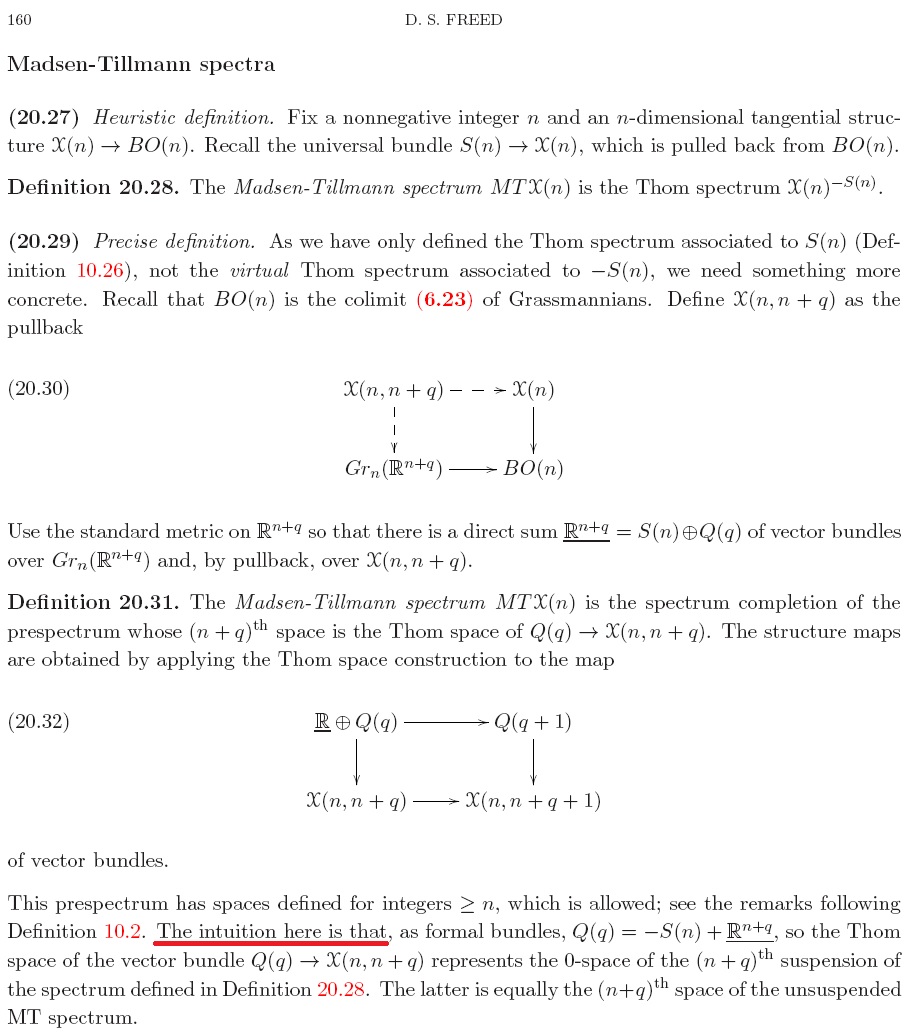As I understand, the question is about virtual Thom spectra, rather then specifically the Madsen-Tillmann spectra. For what it is worth, here is how I like to think about this.
To understand virtual bundles and their Thom spectra, consider first bundles over the one point space. Such a "bundle" is the same thing as a vector space ${\mathbb R}^n$. The Thom space of this bundle is the sphere $S^n$ - the one point compactification of ${\mathbb R}^n$. In the world of spaces, there is no meaning to the notion of a negative-dimensional sphere. However, if you pass to the world of spectra, negative-dimensional spheres are well-defined. $S^{-n}$ can be defined as the Spanier-Whitehead dual of $S^n$, which is the same as the function spectrum $F(S^n, S^0)$. So we can say that $S^{-n}$ is the Thom spectrum of the "virtual vector space" $-{\mathbb R}^n$.
Integers can be defined as formal differences of positive integers. Virtual vector spaces (or more generally virtual bundles) are formal differences of vector spaces (bundles). (So if you want to ask why virtual vector bundles are "useful" you can begin by asking why not necessarily positive integers are useful). In the same vein, the ($\infty$-)category of spectra is obtained from the ($\infty$-)category of spaces by inverting the spheres. The Thom spectrum of a virtual vector space is a formal difference of spheres. Note that the equivalence $S^m \wedge S^n\simeq S^{m+n}$ holds in the category of spectra, for all integers $m, n$.
Moving to bundles over a general space $X$. To specify a vector bundle $\eta$ over $X$, say of dimension $n$, is the same as to specify a space $\tilde X$ with a free action of $O(n)$, such that that $X$ is identified with the quotient space of this action and the quotient map $\tilde X\to X$ is a fiber bundle. $\tilde X$ can be constructed as the pullback of the diagram $X \to BO(n) \leftarrow EO(n)$. Then the Thom space of $\eta$ can be defined as the quotient space $\tilde X_+ \wedge_{O(n)} S^n$. The Thom spectrum of $\eta$ is the orbits spectrum $\Sigma^\infty \tilde X_+ \wedge_{O(n)} S^n$. This expression remains meaningful if we replace $S^n$ with any spectrum with an action of $O(n)$, such as $S^{-n}$. So the Thom spectrum of the virtual bundle $-\eta$ can be defined as the spectrum $\Sigma^\infty \tilde X_+ \wedge_{O(n)} S^{-n}$. With this definition, there is an equivalence of spectra $Th(\xi \pm \eta)\simeq Th(\xi)\wedge Th(\pm\eta)$ for any two vector bundles $\xi, \eta$, where $\oplus$ stands for external direct sum.
To connect this with Freed's explanation, note that the Thom space of the trivial bundle of dimension $n$ is equivalent to the smash product $X_+\wedge S^n$ and the Thom spectrum of negative the trivial bundle is the smash product of spectra $\Sigma^\infty X_+\wedge S^{-n}$. Now suppose $\eta$ is a vector bundle over $X$ that embeds as a subbundle of a trivial bundle of dimension $n$. Let $\xi$ be the orthogonal complement of $\eta$. Then you have an equivalence of virtual bundles $-\eta=\xi - n$, and an equivalence of Thom spectra $Th(-\eta)\simeq Th(\xi) \wedge S^{-n}$. I suppose the advantage of this presentation is that it only involves inverting the trivial bundle.

